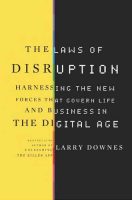The future of emerging technology policy will be influenced increasingly by the interplay of three interrelated trends: “innovation arbitrage,” “technological civil disobedience,” and “spontaneous private deregulation.” Those terms can be briefly defined as follows:
- “Innovation arbitrage” refers to the idea that innovators can, and will with increasingly regularity, move to those jurisdictions that provide a legal and regulatory environment more hospitable to entrepreneurial activity. Just as capital now fluidly moves around the globe seeking out more friendly regulatory treatment, the same is increasingly true for innovations. And this will also play out domestically as innovators seek to play state and local governments off each other in search of some sort of competitive advantage.
- “Technological civil disobedience” represents the refusal of innovators (individuals, groups, or even corporations) or consumers to obey technology-specific laws or regulations because they find them offensive, confusing, time-consuming, expensive, or perhaps just annoying and irrelevant. New technological devices and platforms are making it easier than ever for the public to openly defy (or perhaps just ignore) rules that limit their freedom to create or use modern technologies.
- “Spontaneous private deregulation” can be thought of as de facto rather than the de jure elimination of traditional laws and regulations owing to a combination of rapid technological change as well the potential threat of innovation arbitrage and technological civil disobedience. In other words, many laws and regulations aren’t being formally removed from the books, but they are being made largely irrelevant by some combination of those factors. “Benign or otherwise, spontaneous deregulation is happening increasingly rapidly and in ever more industries,” noted Benjamin Edelman and Damien Geradin in a Harvard Business Review article on the phenomenon.[1]
I have previously documented examples of these trends in action for technology sectors as varied as drones, driverless cars, genetic testing, Bitcoin, and the sharing economy. (For example, on the theme of global innovation arbitrage, see all these various essays. And on the growth of technological civil disobedience, see, “DOT’s Driverless Cars Guidance: Will ‘Agency Threats’ Rule the Future?” and “Quick Thoughts on FAA’s Proposed Drone Registration System.” I also discuss some of these issues in the second edition of my Permissionless Innovation book.)
In this essay, I want to briefly highlight how, over the course of just the past month, a single company has offered us a powerful example of how both global innovation arbitrage and technological civil disobedience—or at least the threat thereof—might become a more prevalent feature of discussions about the governance of emerging technologies. And, in the process, that could lead to at least the partial spontaneous deregulation of certain sectors or technologies. Finally, I will discuss how this might affect technological governance more generally and accelerate the movement toward so-called “soft law” governance mechanisms as an alternative to traditional regulatory approaches.
Comma.ai Case Study, Part 1: The Innovation Arbitrage Threat
The company I want to highlight is Comma.ai, a start-up that had hoped to sell a $999 after-market kit for vehicles called the “Comma One,” which “would give average, everyday cars autonomous functionality.”[2] Created by famed hacker George Hotz, who as a teenager gained notoriety for being the first person to unlock an iPhone in 2007, the Comma One represents an attempt to create autonomous vehicle tech “on the cheap” by using off-the-shelf cameras and GPS technology combined with a healthy dose of artificial intelligence technology.
But regulators at the National Highway Traffic Safety Administration (NHTSA), the federal agency responsible for road safety and automobile regulation, were none too happy to hear about Hotz’s plan to unleash his technology into the wild without first getting their blessing. On October 27, the agency fired off a nastygram to Hotz saying: “We are concerned that your product would put the safety of your customers and other road users at risk. We strongly encourage you to delay selling or deploying your product on the public roadways unless and until you can ensure it is safe.”
Hotz responded on Twitter promptly and angrily. After posting the full NHTSA letter, he said, “First time I hear from them and they open with threats. No attempt at a dialog.” In a follow-up tweet, he said, “Would much rather spend my life building amazing tech than dealing with regulators and lawyers. It isn’t worth it.” And then he announced that, “The comma one is cancelled. comma.ai will be exploring other products and markets. Hello from Shenzhen, China.” A flood of news articles followed about Hotz’s threat to engage in this sort of global innovation arbitrage by bolting US shores.[3]
Incidentally, what Hotz and Comma.ai were proposing to do with Comma One—i.e., deploy autonomous vehicle tech into the wild without prior regulatory approval—was recently done by Otto, a developer of autonomous trucking technology. As Mark Harris reported on Backchannel:
When Otto performed its test drive — the one shown in the May video — it did so despite a clear warning from Nevada’s Department of Motor Vehicles (DMV) that it would be violating the state’s autonomous vehicle regulations. When the DMV realized that Otto had gone ahead anyway, one official called the drive “illegal” and even threatened to shut down the agency’s autonomous vehicle program.”[4]
While Nevada regulators were busy firing off angry letters, Otto was busy doing even more testing in others states (like Ohio), which are eager to make their jurisdictions a testbed for autonomous vehicle innovation.[5] In fact, just recently, Ohio Gov. John Kasich announced the creation of the “Smart Mobility Corridor,” which, according to the Dayton Daily News, will be “a 35-mile stretch of U.S. 33 in central Ohio that runs through Logan County. Officials say that section of U.S. 33 will become a corridor where technologies can be safely tested in real-life traffic, aided by a fiber-optic cable network and sensor systems slated for installation next year.”[6]
This is an example of innovation arbitrage will increasingly take root here domestically as well as abroad, and some states (or countries) will use inducements in an effort to lure innovators to their jurisdictions.
Anyway, let’s get back to the Comma One case study. I don’t want to get too sidetracked regarding the merits of the concerns raised by NHTSA in its letter to Hotz and the implications of the agency’s threats for innovation in this space. But EFF board member Brad Templeton did a nice job addressing that issue in an essay about NHTSA’s letter that threatened Comma. As Templeton observed:
I will presume the regulators will say, “We only want to scare away dangerous innovation” but the hard truth is that is a very difficult thing to judge. All innovation in this space is going to be a bit dangerous. It’s all there trying to take the car — the 2nd most dangerous legal consumer product — and make it safer, but it starts from a place of danger. We are not going to get to safety without taking risks along the way.[7]
This gets to the very real trade-offs in play in the debate over driverless car technology and its regulation. In fact, my Mercatus Center colleague Caleb Watney and I recently filed comments[8] with NHTSA addressing the agency’s recently proposed “Federal Automated Vehicles Policy.”[9] We stressed the potentially deleterious implications of prior regulatory restraints on autonomous vehicle innovation by stressing the horrific real-world baseline we live with today, in which over 35,000 people dying on US roadways in 2015 (roughly 96 people per day) and 94 percent of all those crashes being attributable to human error.
Caleb and I noted that, by imposing new preemptive constraints on the coding of superior autonomous driving technology, “NHTSA’s proposed policy for automated vehicles may inadvertently increase the number of total automobile fatalities by delaying the rapid development and diffusion of this life-saving technology.” Needless to say, if that comes to pass, it would be a disaster because “automation on the roads could be the great public-health achievement of the 21st century.”[10]
In our filing, Caleb and I estimated that, “If NHTSA’s proposed premarket approval process slows the deployment of HAVs by 5 percent, we project an additional 15,500 fatalities over the course of the next 31 years. At 10 percent regulatory delay, we project an additional 34,600 fatalities over 33 years. And at 25 percent regulatory delay, we project an additional 112,400 fatalities over 40 years.[11]
So, needless to say, this is a very big deal.
But let’s ignore all those potential foregone benefits for the moment and just stick with the question of whether Hotz’s threat to engage in a bit of global innovation arbitrage (by moving to China or somewhere else) could work, or at least affect policy in some fashion. I think it absolutely could be an effective threat both because (a) policymakers really do want to do everything they can to achieve greater road safety, and (b) the auto sector remains a hugely important industry for the United States, and one that policymakers will want to do everything in their power to retain on our shores.
Moreover, as Templeton observes that “Comma is not the only company trying to build a system with pure neural networks doing the actual steering decisions.” Even if NHTSA succeeds in bringing Comma to heel, there will be others who will follow in its footsteps. It might be a firm like Otto, but there are many other players in this space today, including big dogs like Tesla and Google. If ever there was a truly global technology industry, it the automotive sector. Autonomous vehicle innovation could take root and blossom in almost any country in the world, and many countries will be waiting with open arms if America screws up its regulatory process.
As Templeton concludes:
The USA and California led the way in robocars in part because it was unregulated. In the USA, everything is permitted unless it was explicitly forbidden and nobody thought to write “no robots” in the laws. Progress in other countries where everything is forbidden unless it is permitted was much slower. The USA is moving in the wrong direction.[12]
Comma.ai Case Study, Part 2: The Technological Civil Disobedience Threat
But an interesting thing happened on the way to Comma’s threatened exodus. On November 30, the firm announced that it would now be open sourcing the code for its autonomous vehicle technology. Reporters at The Verge noted that, during a press conference:
Hotz said that Comma.ai decided to go open source in an effort to sidestep NHTSA as well as the California DMV, the latter of which he said showed up to his house on three separate occasions. “NHTSA only regulates physical products that are sold,” Hotz said. “They do not regulate open source software, which is a whole lot more like speech.” He went on to say that “if the US government doesn’t like this [project], I’m sure there are plenty of countries that will.”[13]
So here we see Hotz combining the threat of still potentially taking the project offshore (i.e., global innovation arbitrage) with the suggestion that by open-sourcing the code for Comma One he might be able to get around the law altogether. We might consider that an indirect form of technological civil disobedience.
Incidentally, Hotz may not be aware of the fact that NHTSA is in the process of making a power-play to become a driverless car code cop. While Hotz is technically correct that, under current law, NHTSA officials “do not regulate open source software, which is a whole lot more like speech,” NHTSA’s recent Federal Automated Vehicles Policy claimed that the agency “has authority to regulate the safety of software changes provided by manufacturers after a vehicle’s first sale to a consumer” while also suggesting that the agency “may need to develop additional regulatory tools and rules to regulate the certification and compliance verification of such post-sale software updates.”[14]
Needless to say, this proposal has important ramifications for not only Comma, but all other firms in this sector. Consider the implications for Tesla’s “autopilot” mode, which is really little more than a string of constantly-evolving code it pushes out to offer greater and greater autonomous driving functionality. How would that iterative process work if every time Tesla wanted to make a little tweak to its code it had to run to Washington and file paperwork with NHTSA petitioning for permission to experiment and improve their systems? And then think about all the smaller innovators out there who want to be the next Elon Musk or George Hotz but do not yet have the resources or political connections in Washington to even go through this complex and costly process.
In any event, I have no idea if Hotz or Comma.ai will follow through with any of these threats or be successful in doing so. It may be the case that he is just blowing off smoke and that he and his firm will end up staying in the U.S. and perhaps even later reversing course on the decision to open source the Comma code. But to the extent that innovators like Hotz even hint that they might split the country or open source their code to avoid burdensome regulatory regimes, it can have an influence on future policy decisions. Or at least it should.
New Tech Realities & Their Policy Implications
Indeed, the increasing prevalence of global innovation arbitrage and technological civil disobedience raise some interesting issues for the governance of emerging technologies going forward. The traditional regulatory stance toward many existing sectors and technologies will be challenged by these realities. That’s because most of those traditional regulatory systems are highly precautionary, preemptive, and prophylactic in character. They generally opt for policy solutions that are top-down, overly rigid, and bureaucratic.
 This results in a slow-moving and sometimes completely stagnant regulatory approval process that can stop innovation dead in its tracks, or at least delay it for many years. Such systems send innovators a clear message: You are guilty until proven innocent and must receive some bureaucrat’s blessing before you can move forward.
This results in a slow-moving and sometimes completely stagnant regulatory approval process that can stop innovation dead in its tracks, or at least delay it for many years. Such systems send innovators a clear message: You are guilty until proven innocent and must receive some bureaucrat’s blessing before you can move forward.
Of course, in the past, many innovators (especially smaller scale entrepreneurs) really couldn’t do much to avoid similar regulatory systems where they existed. You either fell into line, or else! It wasn’t always clear what “or else!” would entail, but it could range from being denied a permit/license to operate, waiting months or years for rules to emerge, dealing with fines or other penalties, or some combination of all those things. Or perhaps you would just give up on your innovative idea altogether and exit the market.
But the world has changed in some important ways in recent years. Many of the underlying drivers of the digital revolution—massive increases in processing power, exploding storage capacity, steady miniaturization of computing, ubiquitous communications and networking capabilities, the digitization of all data, and more—are beginning to have a profound impact beyond the confines of cyberspace.[15] As venture capitalist Marc Andreessen explained in a widely read 2011 essay about how “software is eating the world”:
More and more major businesses and industries are being run on software and delivered as online services—from movies to agriculture to national defense. Many of the winners are Silicon Valley-style entrepreneurial technology companies that are invading and overturning established industry structures. Over the next 10 years, I expect many more industries to be disrupted by software, with new world-beating Silicon Valley companies doing the disruption in more cases than not.
Why is this happening now? Six decades into the computer revolution, four decades since the invention of the microprocessor, and two decades into the rise of the modern Internet, all of the technology required to transform industries through software finally works and can be widely delivered at global scale.[16]
We can add to this list of a new realities the more general problem of technology accelerating at an unprecedented pace. This is what philosophers of technology call the “pacing problem.” In his new book, A Dangerous Master: How to Keep Technology from Slipping beyond Our Control, Wendell Wallach concisely defined the pacing problem as “the gap between the introduction of a new technology and the establishment of laws, regulations, and oversight mechanisms for shaping its safe development.” “There has always been a pacing problem,” Wallach correctly observed, but like other philosophers, he believes that modern technological innovation is accelerating much faster than it was in the past.[17]
What are the ramifications of all this for policy? As technology lawyer and consultant Larry Downes has noted, lawmaking in the information age is now inexorably governed by the “law of disruption” or the fact that “technology changes exponentially, but social, economic, and legal systems change incrementally.”[18] This law is “a simple but unavoidable principle of modern life,” he said, and it will have profound implications for the way businesses, government, and culture evolve. “As the gap between the old world and the new gets wider,” he argues, “conflicts between social, economic, political, and legal systems” will intensify and “nothing can stop the chaos that will follow.”[19]
The end result of the “law or disruption” and a world relentlessly governed by the ever-accelerating “pacing problem” is that it will be harder than ever to effectively control emerging technologies using traditional legal and regulatory systems and mechanisms. And this makes it even more likely that the related threats of global innovation arbitrage and various forms of technological civil disobedience will become more regular fixtures in debates about many emerging technologies.
New Governance Models
How one reacts to these new realities will depend upon their philosophical disposition toward innovative activities more generally.
Consider first those adhering to a more “precautionary principle” mindset, which I have defined in my recent book as those who believe “that new innovations should be curtailed or disallowed until their developers can prove that they will not cause any harm to individuals, groups, specific entities, cultural norms, or various existing laws, norms, or traditions.”[20]
Needless to say, the precautionary principle crowd with be dismayed by these new trends and perhaps even decry them as “lawlessness.” Some of these folks seem to be in denial about these new realities and pretend that nothing much has changed. Yet, I have found that most precautionary principle-oriented advocates, and even many regulatory agencies themselves, tend to acknowledge these new realities. But they remain very uncertain about how best to respond to them, often just suggesting that we’ll all need to just try harder to impose new and better regulations on a more expedited or streamlined basis.
Of course, those of us who generally embrace the alternative policy vision for technological governance—“permissionless innovation”—are going to be more accepting of the new technological realities I have described, and we will perhaps even work to defend and encourage them. But while I count myself among this crowd, we cannot ignore the fact that many serious challenges will arise when innovation outpaces law or can easily evade it.
There is some middle ground here, although it is very messy middle ground.
The era of technocratic, top-down, one-size-fits-all regulatory regimes is fading, or at least being severely strained. We will instead need to craft flexible and adaptive policies going forward that are bottom-up, flexible, and evolutionary in character.
What that means in practice is that a lot more “soft law” and informal governance mechanisms will become the new norm. I wrote about this new policy environment in my recent essay, “DOT’s Driverless Cars Guidance: Will ‘Agency Threats’ Rule the Future?” as well as this lengthy review of Wendell Wallach’s latest book about technology ethics. Along with Gary Marchant of the Arizona State University law school, Wallach recently published an excellent book chapter on “Governing the Governance of Emerging Technologies,” which discussed these soft law mechanisms, which include: “codes of conduct, statements of principles, partnership programs, voluntary programs and standards, certifications programs and private industry initiatives.”[21]
Their chapter appears in an important collection of essays that Gary Marchant edited with Kenneth W. Abbott and Braden Allenby entitled, Innovative Governance Models for Emerging Technologies.
What is interesting about the chapters in that book is that seemingly widespread consensus now exists among experts in this field that some combination of these soft law mechanisms are likely to become the primary mode of technological governance for the indefinite future. This is because, as Marc A. Saner points out in a different chapter of that book, “the control paradigm is too limited to address all the issues that arise in the context of emerging technologies.”[22] By the control paradigm, he generally means traditional administrative regulatory agencies and processes. He and other contributors in the book all seem to agree that the control problem paradigm “has its limits when diffusion, pacing and ethical issues associated with emerging technologies become significant, as is often the case.”[23]
And so the traditional command-and-control ways will gradually give way to a new paradigm for emerging technology governance. In fact, as I noted in my recent essay on driverless cars, we see this happening quite a bit already. “Multistakeholder processes” are already all the rage in the world of emerging technologies and their governance. In recent years, we have seen the White House and various agencies (such as the FTC, NTIA, FDA, and others) craft multistakeholder agreements or best practice guidance documents for technologies as far ranging as:
- Drones & privacy
- Sharing economy
- Internet of Things
- Driverless cars
- Big data
- Artificial intelligence
- Cross-device tracking
- Native advertising
- Online data collection
- Mobile app transparency and security
- Mobile apps for kids
- Mobile medical apps
- Online health advertising
- 3D printing
- Facial recognition
And that list is not comprehensive. I know I am missing other multistakeholder efforts, best practices, or industry guidance documents that have been crafted in recent years.
Of course, many challenging issues need to be sorted out here, most notably: how transparent and accountable will these soft law systems be in practice? How will they be enforced? And what will happen to all those existing laws, regs, and agencies that will continue to exist? More generally, it is worth asking whether we can more closely study these various multistakeholder arrangements and soft law governance mechanisms and determine if there are certain principles or strategies that could be applicable across a wide class of technologies and sectors. In other words, can we a do a better job of “formalizing the informal,” without falling right back into the trap of trying to impose rules in a rigid, top-down, one-size-fits-all fashion?
Conclusion
Those are just a few of the hard questions we will need to consider going forward. For now, however, I think it is safe to conclude that we will no longer see much “law” being made for emerging technologies, at least not in the traditional sense of the term. Thanks to the new technological realities I have described here—and the relentless reality of the “pacing problem” more generally—I believe we are witnessing a wide-ranging and quite profound transformation in how technology is governed in our modern world. And I believe this movement away from traditional “hard law” and toward “soft law” governance mechanisms is likely to accelerate due to the increasing prevalence of innovation arbitrage, technological civil disobedience, and spontaneous private deregulation.
The ramifications of this transformation will be studied by philosophers, legal theorists, and political scientists for many decades to come. But we are still in the early years of this momentous transformation in technological governance and we will continue to struggle to figure out how to make it all work, as messy as it all may be.
_______
[Note: This essay is condensed from a manuscript I have been working on about The Rise of Technological Civil Disobedience. I’m not sure I will ever get around to finishing it, however, so I thought I would at least post this piece for now. In a subsequent essay, which is also part of that draft manuscript, I hope to discuss how this process might play out for technologies that are “born free” versus those that are “born in captivity.” That is, how likely is it that the trends I discuss here will take hold for technologies that have no pre-existing laws or agencies, while other technologies that are born into a regulatory environment are potentially doomed to be pigeonholed into those old regulatory regimes? What are the chances that the latter technologies can escape captivity and gain the freedom the other technologies already enjoy? How might technology-enabled “spontaneous private deregulation” be accelerated for those sectors? Is that always desirable? Again, I will leave these questions for another day. Scholars and students who are interested in these topics can feel free to contact me if they are interested in discussing them as well as potential paper ideas. Regardless of how you feel about these trends, these issues are ripe for intellectual exploration.]
[1] Benjamin Edelman and Damien Geradin, “Spontaneous Deregulation,” Harvard Business Review, April 2016, https://hbr.org/2016/04/spontaneous-deregulation.
[2] Megan Geuss, “After mothballing Comma One, George Hotz releases free autonomous car software,” Ars Technica, November 30, 2016, http://arstechnica.com/cars/2016/11/after-mothballing-comma-one-george-hotz-releases-free-autonomous-car-software.
[3] See: “NHTSA Scared This Self-Driving Entrepreneur Off the Road,” Bloomberg Technology, October 28, 2016, https://www.bloomberg.com/news/articles/2016-10-28/nhtsa-scared-this-self-driving-entrepreneur-off-the-road; Sean O’Kane, “George Hotz cancels his self-driving car project after NHTSA expresses concern,” The Verge, October 28, 2016, http://www.theverge.com/2016/10/28/13453344/comma-ai-self-driving-car-comma-one-kit-canceled; Brad Templeton, “Comma.ai cancels comma-one add-on box after threats from NHTSA,” Robohub, October 31, 2016, http://robohub.org/comma-ai-cancels-comma-one-add-on-box-after-threats-from-nhtsa.
[4] Mark Harris, “How Otto Defied Nevada and Scored a $680 Million Payout from Uber,” Backchannel, November 28, 2016, https://backchannel.com/how-otto-defied-nevada-and-scored-a-680-million-payout-from-uber-496aa07f5ba2#.9rmtb29bl
[5] Larry E. Hall, “Otto Self-Driving Truck Tests in Ohio; Violated Nevada Regulations,” Hybrid Cars, November 29, 2016, http://www.hybridcars.com/otto-self-driving-truck-tests-in-ohio-violated-nevada-regulations.
[6] Kara Driscoll, “Ohio to create ‘smart’ road for driverless trucks,” Dayton Daily News, November 30, 2016, http://www.daytondailynews.com/business/ohio-create-smart-road-for-driverless-trucks/25qC7uYjz9rE96q6YFVUUK.
[7] Brad Templeton, “Comma.ai cancels comma-one add-on box after threats from NHTSA,” Robohub, October 31, 2016, http://robohub.org/comma-ai-cancels-comma-one-add-on-box-after-threats-from-nhtsa/
[8] Adam Thierer and Caleb Watney, “Comment on the Federal Automated Vehicles Policy,” November 22, 2016, https://www.researchgate.net/publication/311065194_Comment_on_the_Federal_Automated_Vehicles_Policy.
[9] National Highway Traffic Safety Administration (NHTSA), Federal Automated Vehicles Policy, September 2016.
[10] Adrienne LaFrance, “Self-Driving Cars Could Save 300,000 Lives per Decade in America,” Atlantic, September 29, 2015
[11] Adam Thierer and Caleb Watney, “Comment on the Federal Automated Vehicles Policy,” November 22, 2016, https://www.researchgate.net/publication/311065194_Comment_on_the_Federal_Automated_Vehicles_Policy.
[12] Templeton.
[13] Sean O’Kane and Lauren Goode, “George Hotz is giving away the code behind his self-driving car project,” The Verge, November 30, 2016, http://www.theverge.com/2016/11/30/13779336/comma-ai-autopilot-canceled-autonomous-car-software-free.
[14] NHTSA, Federal Automated Vehicles Policy, 76.
[15] Adam Thierer, Jerry Brito, and Eli Dourado, “Technology Policy: A Look Ahead,” Technology Liberation Front, May 12, 2014, http://techliberation.com/2014/05/12/technology-policy-a-look-ahead.
[16] Marc Andreessen, “Why Software Is Eating the World,” Wall Street Journal, August 20, 2011, http://www.wsj.com/articles/SB10001424053111903480904576512250915629460.
[17] Wendell Wallach, A Dangerous Master: How to Keep Technology from Slipping beyond Our Control (New York: Basic Books, 2015), 60.
[18] Larry Downes, The Laws of Disruption: Harnessing the New Forces That Govern Life and Business in the Digital Age 2 (2009).
[19] Id.
[20] Thierer, Permissionless Innovation, at 1.
[21] Gary E. Marchant and Wendell Wallach, “Governing the Governance of Emerging Technologies,” in Gary E. Marchant, Kenneth W. Abbott & Braden Allenby (eds.), Innovative Governance Models for Emerging Technologies (Cheltenham, UK: Edward Elgar, 2013), 136.
[22] Marc A. Saner, “The Role of Adaptation in the Governance of Emerging Technologies,” in Gary E. Marchant, Kenneth W. Abbott & Braden Allenby (eds.), Innovative Governance Models for Emerging Technologies (Cheltenham, UK: Edward Elgar, 2013), 106.
[23] Ibid., at 94.






 The Technology Liberation Front is the tech policy blog dedicated to keeping politicians' hands off the 'net and everything else related to technology.
The Technology Liberation Front is the tech policy blog dedicated to keeping politicians' hands off the 'net and everything else related to technology.